Key takeaways:
- Textures in photography convey depth and emotion, enhancing the storytelling of an image.
- Black and white photography emphasizes shadows and light, revealing layers of meaning and adding a timeless quality.
- Techniques like adjusting depth of field and using proper lighting can significantly enhance texture in images.
- Equipment such as macro lenses, tripods, and polarizing filters are essential for capturing intricate textures and details.
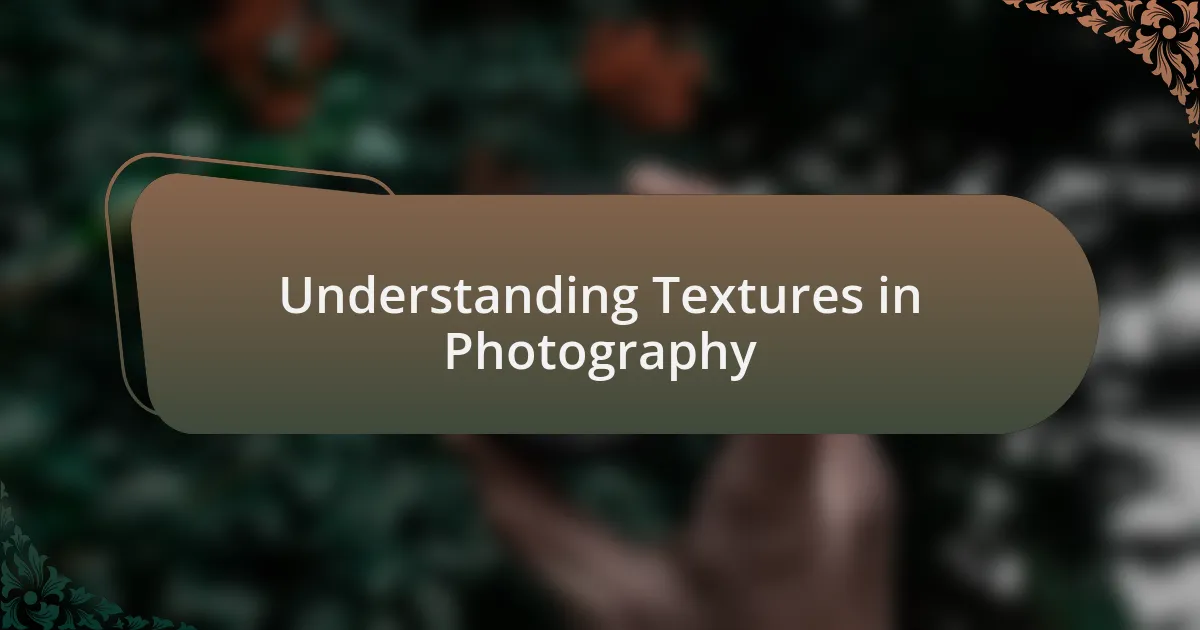
Understanding Textures in Photography
Textures in photography play a crucial role in conveying depth and emotion. I’ve often found that an intriguing texture can evoke feelings that a simple image might not. For instance, the roughness of an old, weathered door can make you feel the passage of time, while the smoothness of a polished surface might create a sense of calm. Don’t you think that the materials used in a scene can tell their own story?
When I shoot in black and white, textures become the stars of the show. The absence of color allows the intricate details—like the delicate folds of a fabric or the sharp lines of a rugged wall—to emerge in striking contrast. I vividly remember capturing a close-up of tree bark in an abandoned park; the crisscrossing patterns seemed almost alive, whispering tales of nature’s resilience. I wondered how a colorless palette could bring out such vivid stories.
In my experience, understanding textures requires more than just observation; it necessitates an emotional connection. Have you ever paused to really feel the difference between soft grass underfoot and coarse gravel? This physical awareness translates into how I frame my shots, making my photographs resonate on a deeper level. I encourage you to consider how different textures can transform the message of your images.
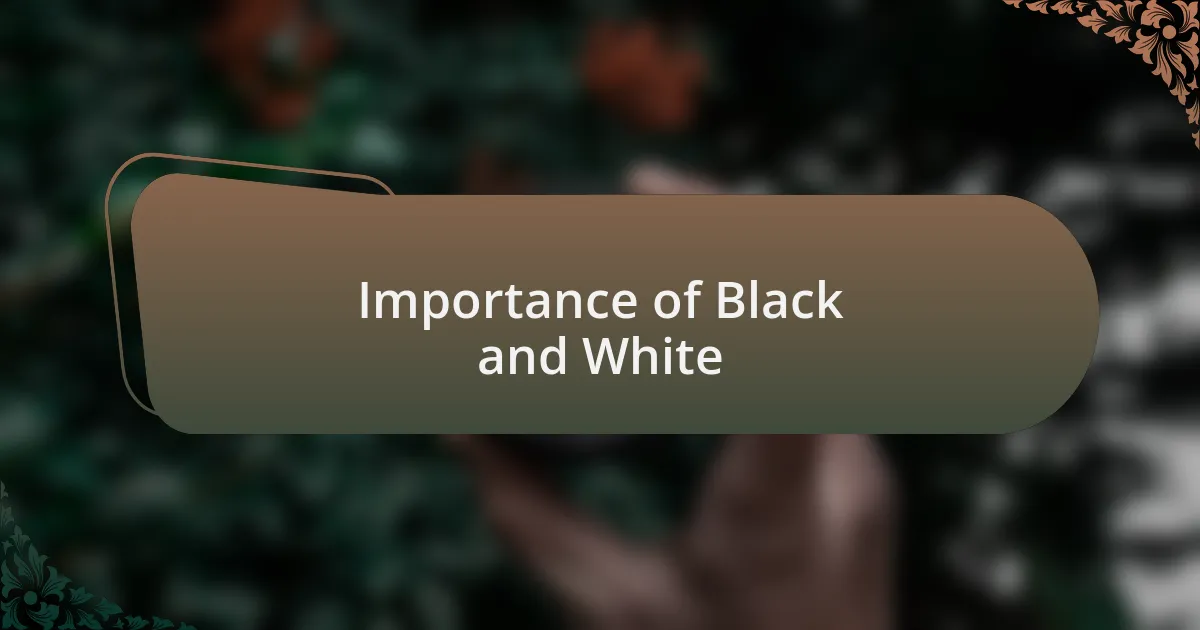
Importance of Black and White
Black and white photography carries an intrinsic power that heightens the emotional weight of an image. I remember the first time I edited a photo from a vibrant sunset to grayscale; the result was a hauntingly beautiful silhouette that spoke volumes more than the original color version. Have you ever felt that a black and white image can resonate deeper within you than a colorful one? It strips away distractions, forcing us to confront the essence of the subject.
The subtleties of shadow and light in black and white can reveal layers of meaning in a way that color often obscures. During my photography journey, I experimented with lighting in a dimly lit alley, where the interplay of shadows accentuated every stone and crevice. The resulting image seemed to breathe with a history, drawing viewers into its narrative. Isn’t it remarkable how monochrome can transform a mundane scene into something profound?
Moreover, black and white imagery cultivates a timeless quality that speaks to the human experience. I once captured an elderly couple holding hands on a park bench, their faces etched with stories of decades spent together. When I converted that image to black and white, it became a universal symbol of love and companionship, stripping away the details that might date the photograph. Don’t you think that in this way, black and white art can transcend time and connect us all?
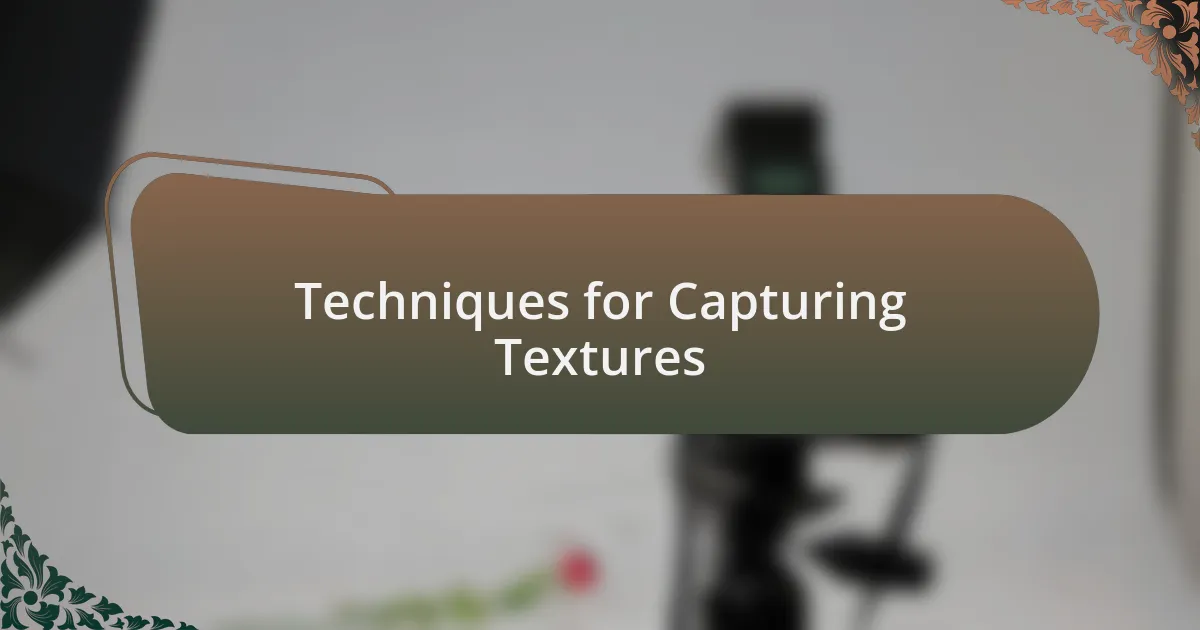
Techniques for Capturing Textures
Capturing textures in black and white photography requires a keen eye for detail. I often find myself drawn to the weathered surfaces of old buildings, where peeling paint and rust tell a story of time. Isn’t it fascinating how a simple wall, devoid of color, can evoke such a profound sense of nostalgia and history?
Lighting plays a crucial role in revealing these textures. I recall a morning when I ventured out just after sunrise, the soft light casting gentle shadows on a cobblestone path. The chiaroscuro effect—the interplay of light and dark—highlighted the roughness of the stones, transforming an ordinary scene into something striking. Have you noticed how different times of day can completely alter the mood of your images?
Experimenting with depth of field can also enhance texture in your shots. When I focus on a foreground element, like the intricate veins of a leaf, while blurring the background, it draws the viewer’s attention right where I want it. This technique creates a striking contrast, almost tempting the observer to reach out and touch the textures through the image. Don’t you love how a simple adjustment can lead to such an evocative photograph?
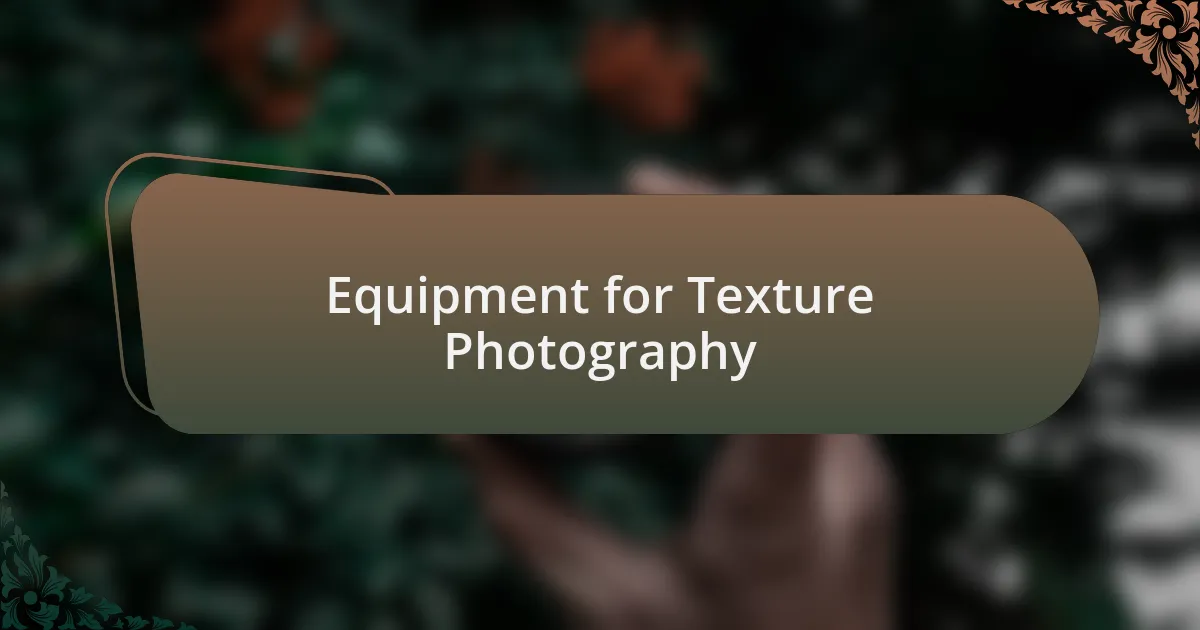
Equipment for Texture Photography
When it comes to equipment for texture photography, I find that the right lens can make all the difference. I often use a macro lens to capture fine details; its ability to bring out the intricate textures of surfaces like tree bark or aged metal is truly remarkable. Have you ever looked so closely at something that it felt like you were discovering a whole new world?
My trusty tripod is another essential tool in my kit. It allows for stability, especially in low-light situations, where longer exposure times are necessary to really capture those nuanced textures. I remember a late-night shoot at an old factory; every detail, every rust patch needed to be sharp and defined, and my tripod made that possible. It’s incredible how much more depth you notice when you can hold your camera steady.
Lastly, I can’t emphasize enough the value of a polarizing filter. This little piece of equipment is fantastic for reducing glare and enhancing contrast, particularly when I’m photographing shiny surfaces or water. I once took a shot of a weathered wooden dock reflecting on still water, and the filter made those textures pop. How do you feel about using filters in your photography journey? They can really elevate the tactile quality of your images, making textures come alive in ways you might not expect.
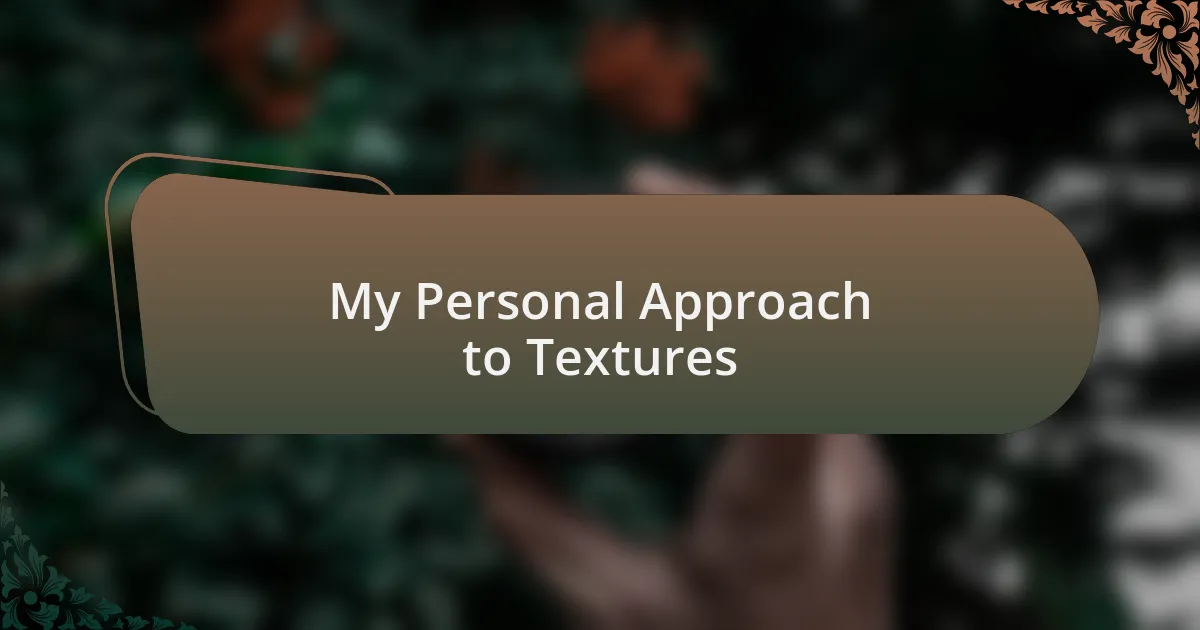
My Personal Approach to Textures
When I approach textures in my photography, I like to start by being truly present in the moment. There’s something magical about slowing down and allowing myself to really see details that often go unnoticed. One time, while wandering through a quaint old town, I stumbled upon a cracked sidewalk. Capturing that texture made me feel connected to the history of the place; it told a story of wear and time that I wanted to share with others.
I also enjoy experimenting with lighting to shape the textures in my images. Backlit surfaces often come alive in striking ways, as shadows and highlights dance across them. I recall a chilly morning when the sun broke through the clouds, casting a golden hue on frosted leaves. The texture of the frost against the vibrant colors was a striking combination—almost surreal. Have you ever noticed how different the same texture can look under varying light conditions? That’s the beauty of photography, isn’t it?
Lastly, I often find inspiration in unexpected places, allowing spontaneity to guide my lens. One memorable instance was when I turned my camera to a rusted bicycle left to age beside a vibrant mural. The juxtaposition of the decaying bike against the colorful wall was striking; it was as if they were having a silent conversation. This approach encourages creativity, reminding me that textures are everywhere, waiting to be discovered. What hidden treasures have you found in your own explorations?
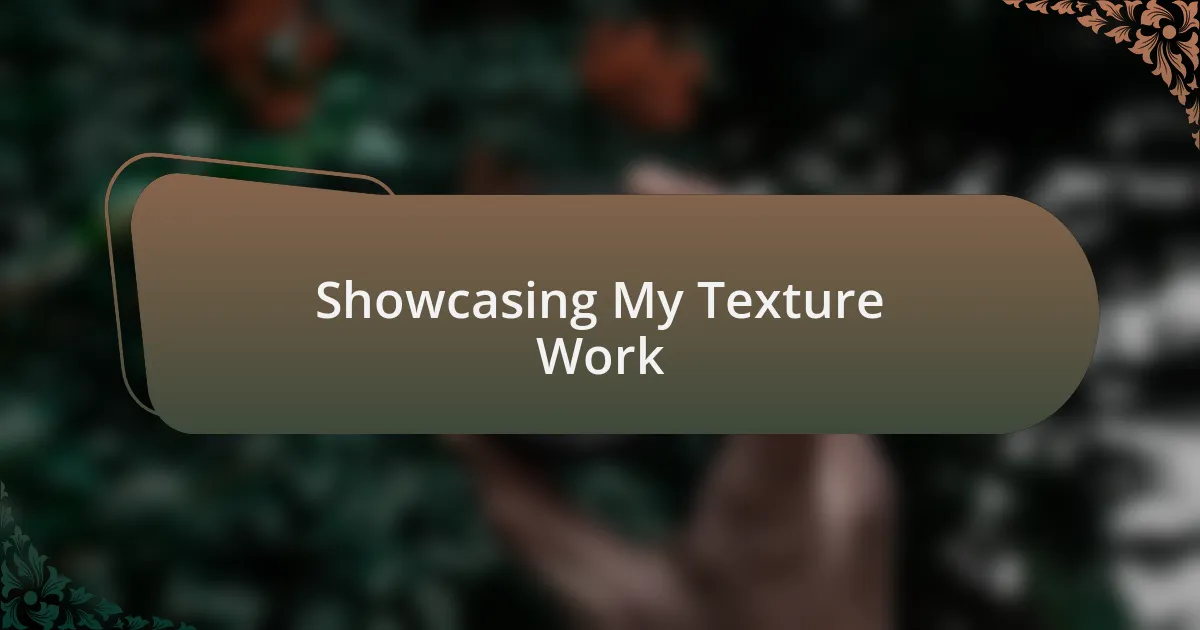
Showcasing My Texture Work
The moments I capture textures often become my favorites, embodying emotions and stories. For example, I spent an afternoon at an abandoned factory, where rusted metal pipes sat silently under layers of dust. As I focused on the intricate patterns and pitted surfaces, I couldn’t help but feel a sense of nostalgia for what once was—each texture whispering tales of labor and progress that time had softened.
One exciting challenge for me is conveying depth and dynamism through my texture work. I’ve taken to using a macro lens to explore natural elements like tree bark or a crumbling wall close-up. Each shot reveals an array of tones and intricate details that I didn’t notice with the naked eye. Have you ever considered how a seemingly ordinary surface can transform into a breathtaking composition through the lens of a camera?
I often showcase my texture work through curated galleries, allowing viewers to journey through each piece as if they were flipping through a tactile storybook. When I arranged a recent exhibit featuring urban textures, I noticed how visitors lingered longest on the shots of peeling paint and weathered wood. It sparked conversations about urban decay and renewal. Isn’t it fascinating how textures can evoke shared feelings and memories, inviting viewers to connect on a deeper level?